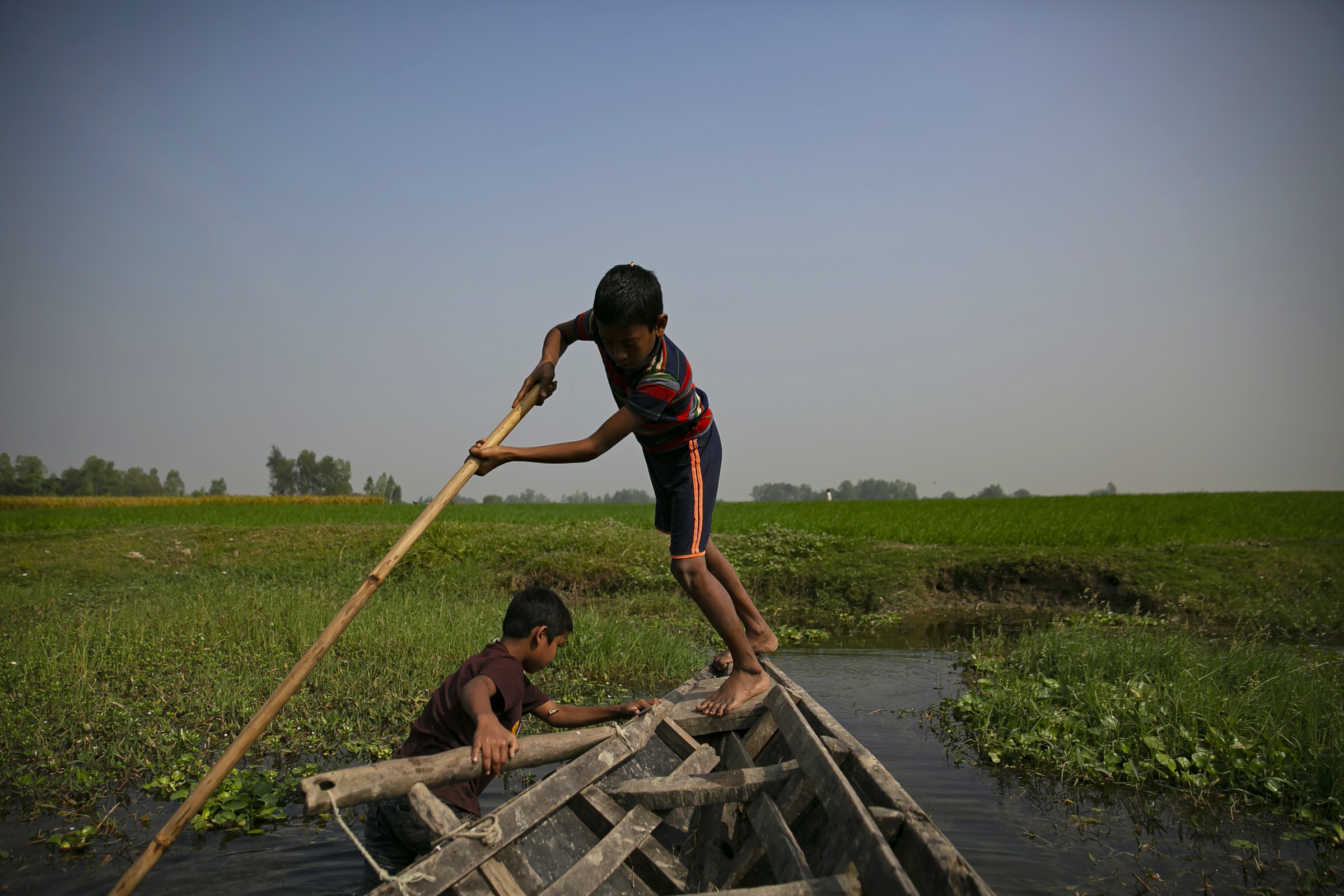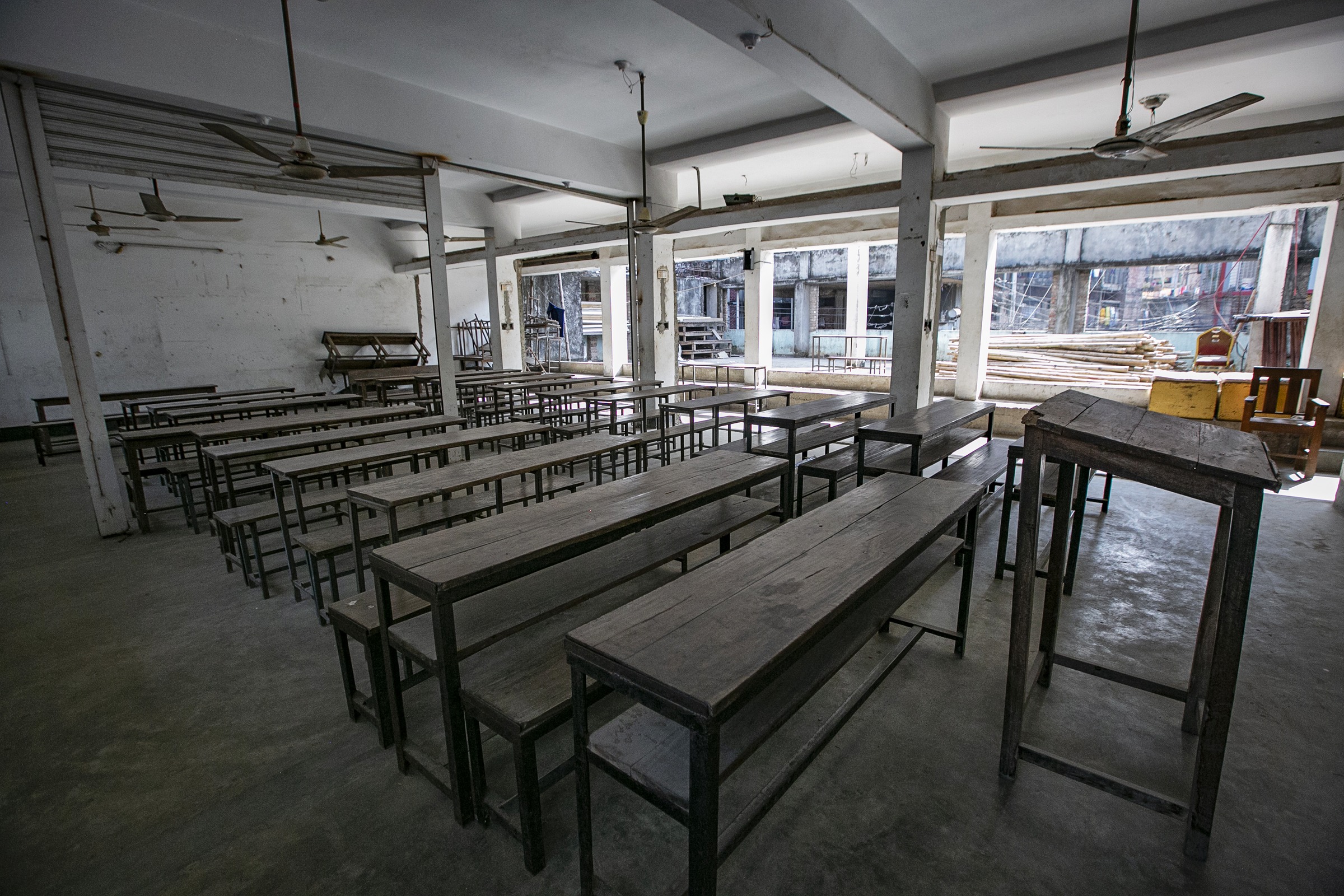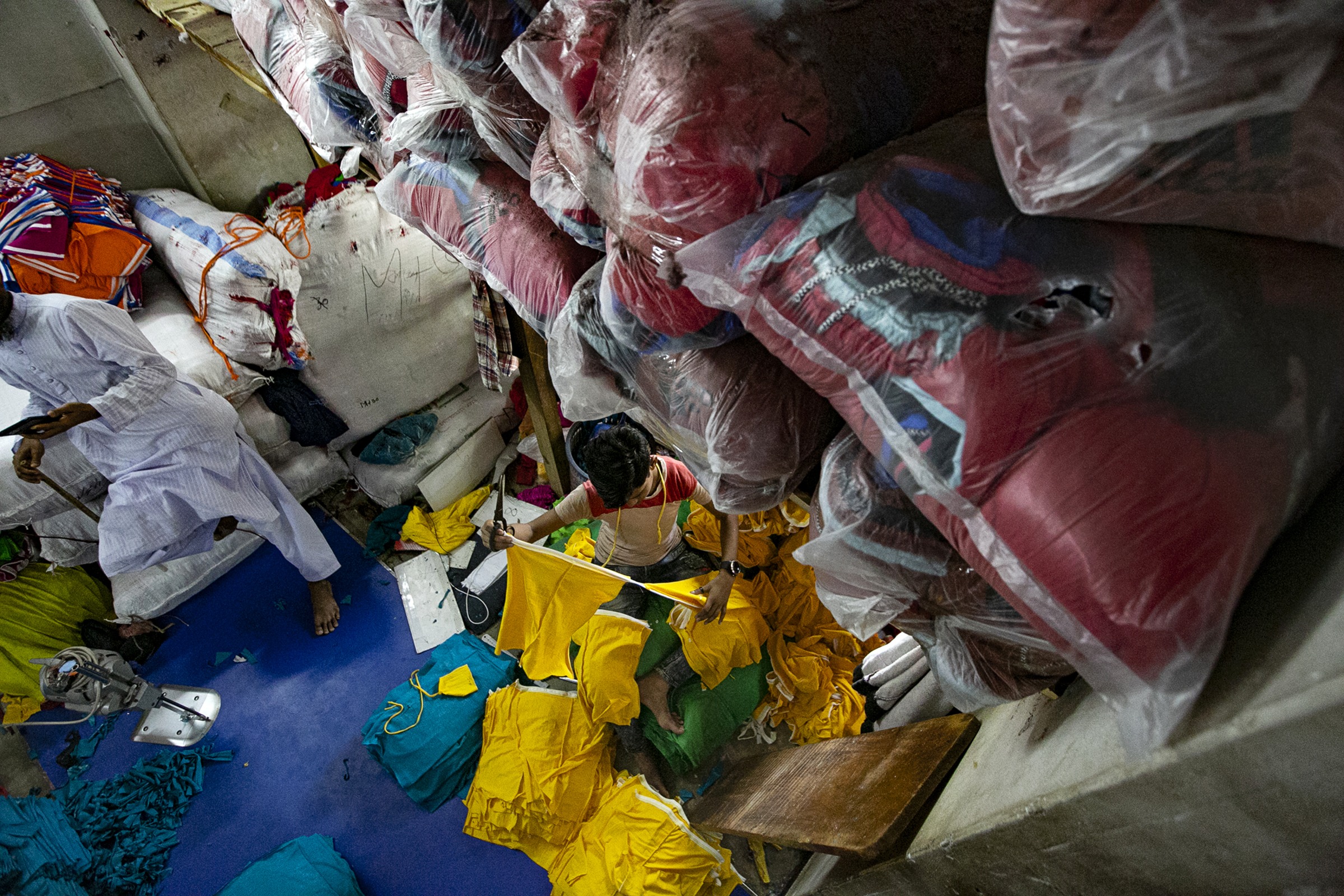
This story was supported by the Pulitzer Center
By the time the sun sinks over the Bangladeshi capital of Dhaka, Rekha is struggling to sit still. Twisting her plastic bangles, the 34-year-old mother of two checks her phone to make sure she hasn’t missed a call from her 12-year-old son, who was due home 30 minutes earlier. Rekha wanders outside to peer through the front gate, anxiety sketched all over her face. “This job is too dangerous,” she says, frowning. “Every morning I say goodbye and I pray, ‘Please Allah, send him home tonight.’”
Rekha has cause to worry. In the 18 months since her elder son Rafi started work in a local glass factory, he’s returned home bruised and bleeding more than once. One afternoon, he severed the soft skin of his palm with a sharp blade intended to slice a window pane. As blood soaked the child’s T-shirt, he was rushed to the emergency room by his employer—but nobody called Rekha to let her know. “I feel bad inside, like I am a bad mother,” she says. “I know Rafi doesn’t want to work. He wants to be at school.”
Read More: How the COVID-19 Pandemic Puts Children at Risk
When authorities first shuttered Bangladesh’s schools in March 2020, nobody could have anticipated they would remain closed for the following 18 months, in what would go on to become one of the most restrictive school closures in the world. Classes returned on a rotating schedule in September 2021, but schools were closed for four weeks over January and February amid a COVID-19 surge driven by the Omicron variant. Now, two years on from the first lockdown, child-rights advocates say that tens of thousands of pupils across the country have not returned to school. The majority, they say, are boys ages 12 and above, who during the interim were pushed into full-time work.
Rafi was once one of more than 1,100 students ages 5 to 17 who attended Shantipur High School in Dhaka until the government imposed its nationwide lockdown in March 2020. In September 2021, the school’s staff heaved open the metal gates that face a busy street in central Dhaka and waited; teachers poised in pressed shirts and blazers waited for them to return, blackboards still damp from a sponge.
But only 700 pupils appeared over the following days, and numbers haven’t increased in the months since. By December, so many of the wooden benches and desks were sitting empty that the school started selling them off as scrap material. Two-thirds of the children missing from the classrooms are adolescent boys. “They are the only wage earners of their families now,” says head teacher Biplab Kumar Saha.

While it’s impossible to know exactly how many children in Bangladesh have started working since the start of the pandemic, attendance figures for 20 schools across the country collated by TIME reveal that boys accounted for at least 59% of dropouts from March 2020 to November 2021, a gender imbalance confirmed by data from the nonprofit organization BRAC.
The growing crisis stirred Bangladeshi authorities to ratify the International Labour Organization’s (ILO) Convention 138 on child labor in March. They declared that no child under the age of 14 should be employed in any industry, and promised to eradicate child labor in its entirety over the next three years. But as household incomes across the country plunged by an average of 23% during the first 18 months of the pandemic, many parents say they’re out of alternatives: unless their son goes to work, his siblings won’t be able to eat.
That wasn’t the case two years ago. When the schools first shut, Rafi’s parents were concerned about their sons’ education—Rafi’s younger brother is just 8—and joined with other neighborhood families to find a private tutor to teach a dozen of the local children for an hour every day. But as weeks passed and Bangladesh remained in lockdown, the family’s financial situation quickly deteriorated.
By the summer of 2020, Rekha’s husband Tajul, a successful entrepreneur, had lost his clothing business and started working two jobs—manning a small roadside stall by day, before patrolling a market as a security guard through the night. The hours were long, and his income still wasn’t enough to pay back microcredit loans and cover rent. Debt collectors began showing up at their door, threatening Rekha, who suffers from abscesses and diabetes and is too sick to work. In desperation, Tajul turned to Rafi. “It wasn’t the plan, but the situation became really bad,” Rekha recalls.
Rekha had never imagined she would be sending her son to work 12-hour days at a glass factory. “But now we are living a devastated life,” she says, gesturing around the bare concrete room where the whole family eats and sleeps.
When the pandemic first hit, concern initially focused on girls being forced into marriage, as struggling families tried to reduce their costs by marrying off their daughters to men sometimes more than twice their age. One survey conducted by the nonprofit Manusher Jonno Foundation recorded almost 14,000 underage marriages across one-third of the country during the first six months of lockdown, with half of the girls ages 13 to 15. At Shantipur High School, where Rafi used to study, the teachers kept careful track of their female pupils. They learned that in most cases, those who dropped out had moved to rural communities and enrolled in schools outside of the city. At least 15 girls were forced into illegal, underage marriage. It’s 15 too many, the school’s head teacher Saha says—–but it’s also fewer than he had feared. What he hadn’t anticipated was the impact the pandemic would have on the boys. “It was beyond our expectation and imagination.”
Secondary education isn’t free in Bangladesh, and tuition fees average approximately 3,000 taka ($35) a year. In a country where 1 in 5 people survived on less than $1.90 per day before the pandemic, the costs of stationery, textbooks, and uniforms also add up fast. Girls ages 11 to 16 typically receive a small uniform stipend and tuition subsidy of up to 3,500 taka ($40) each year from the government in an attempt to counter the threat of child marriage and incentivize their families to keep them in school. “But for families with sons, education presents a significant cost,” says Safi Khan, director of education for BRAC. “It’s an impossible situation, and there is very little support.”
One of the first signs of economic crisis is when adolescent boys begin dropping out of school, says Tuomo Poutiainen, Bangladesh director for the International Labour Organization. “It is gendered,” he says. When schools were closed, most families felt that sending their daughters to work was too much of a risk, but that sons might present an emergency source of income.
Despite millions of dollars in foreign aid supporting girls’ education, child-rights advocates in Bangladesh tell TIME they are struggling to summon equal support for the thousands of adolescent boys who have dropped out of school since the outbreak of COVID-19. It’s as if donors are “intentionally blind” to child labor, says Tony Michael Gomes, director of World Vision Bangladesh. “I see a huge disconnection … If you really ask what exactly they’re funding and if their resources are impacting the lives of the children, the answer might be no.” Sheldon Yett, UNICEF representative to Bangladesh, agrees. “I don’t want to de-emphasize the risk that girls are under,” he says. “But we must not lose sight of the specific needs of boys.”
For many parents, the costs of their children’s education have collided with mounting debts, leaving them with few options but to pull their sons from their classrooms. “I felt terrible,” says Helena, whose 11-year-old, Alomgir, threw his exercise books in the trash when she told him he couldn’t return to school in September.
When Alomgir’s friends left the village and traipsed along the track to the local elementary a few days later, Helena found her son sobbing in the shade of their wooden hut. “When I saw him crying, I cried too,” she says. She understands his pain. As a child, Helena was top of her class until her brother forced her to drop out of school and marry an older man. She was only 12 years old.
Helena has already had to reconcile herself with depriving one son of an education: five years ago, her husband fell sick, and the family had to send Alomgir’s then 11-year-old brother to work at a brick kiln, where he earns 300 taka ($3.50) a day. “We thought that we could ensure the rest of our sons were educated by sacrificing the eldest one,” Helena says. But when the countrywide lockdown began in March 2020, the kiln closed for four months, and the family had to take out a 40,000-taka ($465) loan to cover rice and medical care. Two years later, they still owe 30,000 taka ($350), and Helena fears it’s Alomgir who will continue to pay the price.
Data on child labor in Bangladesh is notoriously scant. According to the ILO, rates appeared to be decreasing before the pandemic, but there hasn’t been a nationwide, government-led survey on child labor since 2013. In 2019 UNICEF conducted its own study, reporting that 1 in 10 boys ages 12 to 14 in Bangladesh was working full time. Incomes vary, but research suggests the majority of boys under the age of 14 earn less than $40 per month.
“We don’t have updated statistics since the pandemic [began], so we don’t know exactly what the impact is going to be on child labor, but we know anecdotally that it’s a lot worse,” says UNICEF’s Yett.

Even before Bangladesh ratified the convention, its constitution decreed that “hazardous” child labor, such as brick breaking or leather tanning, was illegal—but the current law does not prohibit children under the age of 14 from providing for their families in informal sectors, such as domestic work or agriculture. (Since they are victims of exploitation, TIME has chosen not to publish the faces or surnames of children in this article.) Repercussions for those who employ children in any industry are rare, say child-rights advocates, citing an incident in July 2021 when a fire broke out in a juice factory and killed at least 52 employees, including at least 16 children as young as 11. The owners were briefly arrested and released on bail, but the court case is still pending.
For all the demonstrable dangers, many factory owners say they have seen a marked increase in the number of parents going from door to door over the past two years, offering their small sons up for work. One businessman in Narayanganj, a riverside city southeast of Dhaka, tells TIME that he has employed approximately 10 children in his garment factory since the start of the pandemic. The youngest was 8 years old. “Their age doesn’t matter. Rather, can he cope? Can he deliver?”
The businessman argues that he’s supporting the families the government has failed. “We have too many people in this country and too few resources,” he says. “Education gives no guarantee to [the children’s] future.” A few meters away, two boys, ages 12 and 13, are folding knockoff Adidas tracksuits, coughing on clouds of cotton dust.
As inflation soars, and more families descend into poverty, getting Bangladeshi children out of the workplace and back into schools will take more than the public-facing ratification of the ILO convention establishing that no child under the age of 14 should go to work, says Yett. He notes that the legislation doesn’t even come into effect for another year. “There is no single magic bullet here. Ratification of the convention is critical, but not enough.” There are many factors at play, he says, including the fact that education is compulsory only until age 10, and that there is little to no social support for families facing financial collapse.
Still, since schools partially reopened in September, many teachers have started visiting students’ homes, pleading with their parents in person to return their children to class. “We loved them,” Saha says of his school’s former students, adding that some of his teachers were close to crying when they saw their once overcrowded classrooms filled with empty desks.
Today, two years after he last attended school, Alomgir is silent as he tends to the family’s five goats—scratching one behind her ears as he ushers her toward the pile of grass he cut that morning. His parents don’t want him to join his father and brother at the brick kiln. There is plenty of work on the family’s farm, and Helena isn’t ready to give up her hope that they could find the money for him to resume schooling in the future. “I have to believe I can make it happen,” she says.
Other families are less hopeful. Just a 10-minute walk from where his former classmates are studying English and history, Rafi sweeps the floor of the glass factory under his employer’s watchful eye. Before the pandemic, he was boisterous and talkative, his parents say—a bouncing ball of energy that never kept quiet, and rarely remained still.
These days he returns home exhausted, prone to outbursts of emotion. “Because of you, my life is over,” he tells his mother. Rekha is unsure how to comfort him, fearing he might be right. “We are ruining his future,” she says, blinking back tears.
—With reporting by Simmone Shah/New York
More Must-Reads from TIME
- How Donald Trump Won
- The Best Inventions of 2024
- Why Sleep Is the Key to Living Longer
- Robert Zemeckis Just Wants to Move You
- How to Break 8 Toxic Communication Habits
- Nicola Coughlan Bet on Herself—And Won
- Why Vinegar Is So Good for You
- Meet TIME's Newest Class of Next Generation Leaders
Contact us at letters@time.com